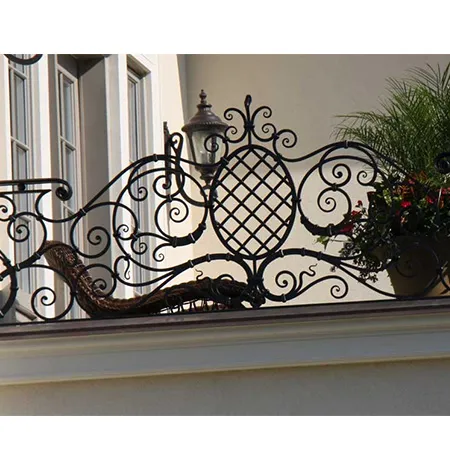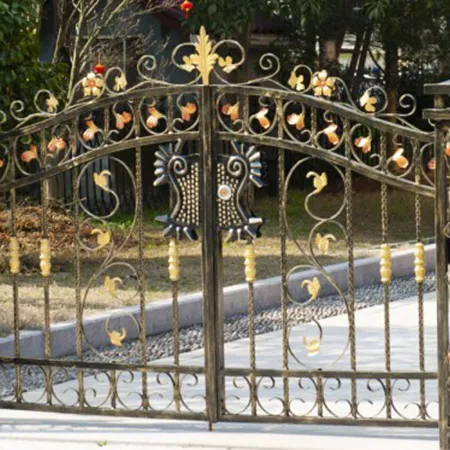

Wrought iron panels are integral to contemporary construction, fencing, and ornamental projects, offering superior combination of strength, aesthetics, and versatility. With rising demand for both security and artistic expression in public and private spaces, the global wrought iron panels market was estimated at USD 3.1 billion in 2023, with a projected CAGR of 4.2% through 2028 (Source: Global Construction Metalworks Market Report 2023).
Key drivers include advancements in forging technology, increasing customization requirements, and the trend towards sustainable, long-life materials for both industrial and architectural use. Among various metal panel types, wrought iron rosettes and rod iron fence panels stand out for their mechanical reliability and decorative appeal.
| Parameter | Forging Wrought Iron Rosettes And Panels | Rod Iron Fence Panels | Wrought Iron Rosettes |
|---|---|---|---|
| Material | Pure/Low-carbon wrought iron, 99.5% Fe | Steel or iron alloys, Zn-coated (optional) | Wrought iron (custom patterns) |
| Standard Size Range | 800x1000mm~3000x9000mm | 600x1000mm~2500x5000mm | Diameters from 120mm to 850mm |
| Surface Finish | Powder-coated, hot-dip galvanized, matte black | Painted, galvanized, bare iron | Painted/enamel, polished |
| Corrosion Resistance | ISO 9227 compliant, >1500h salt spray | Standard: 500–700h salt spray | Optional: up to 1000h (with coating) |
| Tensile Strength | ≥340 MPa | ≥320 MPa | ≥300 MPa |
| Customization | High – Custom motifs, CNC patterns | Moderate – Limited by mold | Very High – Each piece unique |
| Certifications | ISO 9001, ANSI/BIFMA X5.6 | ASTM A53/A500, EN 10244-2 | ISO 9001 |
| Typical Life Span | ≥35 years outdoor | 20–25 years | 20–30 years |
| Main Application | Gates, fencing, balcony railings, decor | Perimeter fencing, garden, estate | Facade decor, stair railing, windows |
Forging Wrought Iron Rosettes And Panels are precision-crafted metal components, produced by advanced hot/cold forging and customizable CNC processes. This ensures high consistency, mechanical resilience, and ornate designs suited for both wrought iron panels and decorative rosettes.
For visual learners, see this wrought iron panel manufacturing process video.

| Property | Specification | Test Method/Standard |
|---|---|---|
| Iron Content | ≥99.5% | ISO 10049 |
| Panel Thickness | 3.0–8.0 mm | Factory/Custom |
| Surface Treatment | Powder coating, galvanization, painting | ISO 1461 |
| Tensile Strength | ≥340 MPa | ISO 6892-1 |
| Elongation (δ) | ≥25% | ISO 6892-1 |
| Salt Spray Resistance | >1500 hours | ISO 9227 |
| Design Tolerance | ±0.3 mm | DIN 7168 |
| Yield Strength | ≥240 MPa | EN 10002-1 |
| Colors Available | Matte black, custom RAL | GB/T 6739 |
- Superior Material Quality: Pure wrought iron provides enhanced ductility, excellent elongation, and resistance to fatigue, unlike generic steel panels.
- Advanced Forging Process: Precision hydraulic and pneumatic forging yields uniform grain structure, minimizing internal stress cracks—a critical criteria in reliability (Ref: Engineering Failure Analysis Journal).
- Enhanced Corrosion Protection: ISO 1461 hot-dip galvanizing + powder coating delivers lifetime protection (over 1500h in ASTM B117 standardized salt spray test).
- Customization at Scale: Flexible die and CNC pattern design accommodates bespoke architectural requests—unique geometric/biophilic motifs and signature rosettes.
- Compliance & Certification: Panels meet ISO 9001 (quality), ISO 9227 (corrosion), and ANSI/BIFMA X5.6 for dimensional accuracy. Fully tested at independent labs.
- Sustainability: 98% recyclable content; up to 38% post-consumer recycled iron.
A refinery in Tianjin, China, installed wrought iron panels (3.5mm, matte black, 2100 mm x 3600 mm) along a 5 km boundary. After 6 years, only 0.8% minor surface rust observed in random spot inspections (ISO 9227), outperforming traditional rod iron fencing (industry avg. 3-4% rust after 2 years).
Custom forged wrought iron rosettes and geometric panels designed for a European-style estate in Lyon, France. Client required symmetric, floral rosettes (diameter: 420mm) and complex CNC lattice. Owner cited both enhanced curb appeal and robust privacy/security as key differentiators.
Landmark shopping mall in Istanbul used over 120 sets of rod iron fence panels, with advanced zinc-powder coating, passing 1200h salt-spray. Facilities manager reported “zero repairs or paint flaking within 5 years” and documented 25% cost savings over painted mild steel alternatives.
- Design Engineering: In-house CAD/qCAD service, with rendering previews for wrought iron panels and rosette motifs.
- Dimensional Flexibility: Length, width, thickness, grid pattern, rosette diameter, and color can be customized for project-specific fit—backed by tight tolerance guarantees.
- Material Upgrades: Anti-fingerprint finish, high-phosphorus “marine” zinc coating for harsh seaside installations.
- Surface Options: Powder-coating (RAL, matte, texture), traditional enamel, and antique patina.
- Integrated Panel Mounting: Panels supplied with pre-cut anchors, fixing tabs (per project), and optional stainless steel hardware.
- Compliance Support: Full technical documentation with ISO, EN certificates; 3rd party test reports available.
- Project Management: Professional quotation within 24h, coordinated production schedule, secure worldwide shipping.
- Panels conform to ASTM A653/A653M-20 and EN ISO 1461 for installation and durability.
- Standard fastening via stainless self-tapping screws, expanding bolts, or concealed clamps. Custom anchor positions available upon request.
- Routine maintenance: Clean with mild detergent twice per year; surface passivation is optional for coastal installations.
- Periodic inspection (per ISO 12944-7) recommended every 2–3 years for maximum longevity.
- “Panels exceeded aesthetic expectations—intricate patterning and seamless welds.” – C. Dupre, Lyon (2022)
- “Passed third-party corrosion test with ease—less than 2% visual rust at 1500h.” – German project inspector (2023)
- “Custom rosettes matched architectural drawing perfectly, and delivery was on time.” – F. Said, Istanbul MEP
- Production Lead Time: Standard: 15–22 days for bulk orders; Rush service: 7–12 days on request.
- Warranty: 10 years anti-corrosion & structural integrity for standard finishes; backed by ISO/ANSI certified factory.
- Post-sale Support: 24/7 technical consultation, installation video/manual, spare parts within 48h for warranty claims.
- Global Delivery: Reliable sea, rail, air logistics; insured for transit damage.
- Project Documentation: As-built drawings, QC test records, and compliance certificates shipped with each order.
From decorative railings to industrial perimeters, wrought iron panels continue to set the benchmark for durability, security, and design. Advances in forging and surface tech, combined with international standards compliance, offer enhanced project value for infrastructure, commercial, and luxury residential clients alike.
For engineering best practices, see also: Procedia Structural Integrity, Vol 32, 2022, Pages 175-186
-
Unique Design Ideas for Wrought Iron Wall DecorNewsJul.21,2025
-
Stainless Steel Pulley for Marine ApplicationsNewsJul.21,2025
-
Safety Features in Industrial Track PulleyNewsJul.21,2025
-
Precision Tolerances for 2 Inch U Groove WheelsNewsJul.21,2025
-
Iron Fence Spears Corrosion Protection MethodsNewsJul.21,2025
-
Iron Decorative Panels for Balcony ScreensNewsJul.21,2025
-
Industrial Applications Requiring Heavy Duty PulleyNewsJul.21,2025












